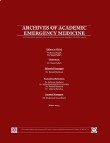Prioritized Criteria for Casualty Distribution following Trauma-related Mass Incidents; a Modified Delphi Study
In the aftermath of mass casualty incidents (MCIs), many decisions need to be made in a fast and influential manner in a high pressure environment to distribute the limited resources among the numerous demands. This study was planned to rank the criteria influencing distribution of casualties following trauma- related MCI.
This study utilized a modified Delphi methodology, concentrating on extracted criteria attained from preceding systematic literature reviews. The 114 extracted criteria were classified into eight sec- tions including space, staff, equipment, system and structures, triage, treatment, transport, and uncategorized criteria and were imported into an online survey tool. In the first round, experts were asked to rank each crite- rion on a five-point Likert scale. The second round incorporated feedbacks from the first round, stating percent and median scores from the panel as a whole. Experts were then called upon to reassess their initial opinions regarding uncertain remarks from the first round, and once again prioritize the presented criteria.
Fifty- seven criteria were regarded as relevant to the following sections: space: 70% (7/10); staff: 44% (4/9); system / structure: 80% (4/5); equipment: 39.1% (9/23); treatment; 66.7% (6/9); triage: 73.7% (14/19); transport: 38.7% (12/31) and other sections: 12.5% (1/8). The ï ˇn ̨Arst round achieved nearly 98% (n=48) response rate. Of the 114 criteria given to the experts, 68 (almost 60%) were approved. The highest percentage of approval belonged to the system and structures sections (4/5=80%). The response rate for the second round was about 86% (n=42). A consensus could be reached about nearly 84% (57) of the 68 criteria presented to experts.
"Casu- alty Level of Triage on the Scene" and "Number of Available Ambulances" were the two criteria that obtained the highest level of consensus. On the other hand, "gender of casualty", "Number of Non-Medical staff in each Hos- pital" and "Desire to transport family members together" got lowest level of consensus. This sorted list could be used as a catalogue for developing a decision support system or tool for distribution of victims following mass casualty incidents.
- حق عضویت دریافتی صرف حمایت از نشریات عضو و نگهداری، تکمیل و توسعه مگیران میشود.
- پرداخت حق اشتراک و دانلود مقالات اجازه بازنشر آن در سایر رسانههای چاپی و دیجیتال را به کاربر نمیدهد.


